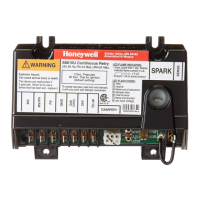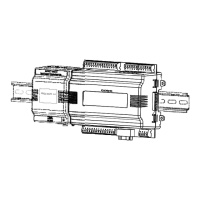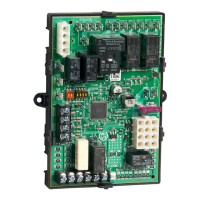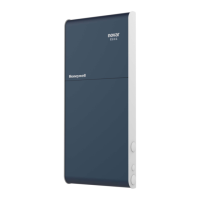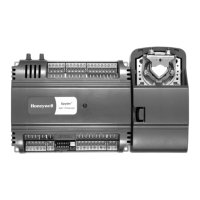S8 610 U UNIVERSAL INTERM ITTEN T P L O T MOD ULE
Step 3: Review normal operating sequence
and module specifications.
a. See Operation and Application sections.
Step 4: Reset the module.
a. Turn the thermostat to its lowest setting.
b. Wait one minute.
As you do Steps 4 and 5, watch for points where operation
deviates from normal. Refer to Troubleshooting Guide, Fig.
7, to correct problem.
Step 5: Check safety shutoff operation.
a. Turn off the gas supply.
b. Set the thermostat or controller above the room
temperature to call for heat.
c. Watch for spark at pilot burner.
d. Time spark from start to shutoff. Spark should shut
off after 90 seconds maximum. Ignition sequence
repeats after five minutes minimum.
e. Open manual gas control knob and make sure no
gas is flowing to pilot or main burner.
f. Set the thermostat below the room temperature and
wait one minute before continuing.
Step 6: Check normal operation.
a. Set the thermostat or controller above the room
temperature to call for heat.
b. Make sure the pilot lights smoothly when the gas
reaches the pilot burner.
c. Make sure the main burner lights smoothly without
flashback.
d. Make sure the burner operates smoothly without
floating, lifting, or flame rollout to the furnace
vestibule or heat buildup in the vestibule.
e. If the gas line has been disturbed, complete the gas
leak test.
Gas Leak Test:
Paint the gas control gasket edges and all pipe connec
tions downstream of the gas control, including pilot
tubing connections, with a rich soap and water solution.
Bubbles indicate gas leaks. Tighten the joints and
screws or replace component to stop gas leak. Recheck
with soap and water solution.
f. Turn the thermostat or controller below the room
temperature. Make sure the main burner and pilot
flames go out.
MAINTENANCE
A WARNING
FIRE OR EXPLOSION HAZARD
CAN CAUSE PROPERTY DAMAGE,
SEVERE INJURY, OR DEATH.
Do not attempt to take the module apart or to clean
it. Improper assembly and cleaning can cause
unreliable operation.
Regular preventive maintenance is important in applica
tions that place a heavy load on system controls, such as
in the commercial cooking and agricultural and industrial
industries because:
• In many applications, particularly commercial cooking,
the equipment operates 100,000 to 200,000 cycles
per year. Such heavy cycling can wear out the gas
control in one to two years.
• Exposure to water, dirt, chemicals and heat can
damage the gas control and shut down the control
system. A NEMA 4 enclosure can reduce exposure to
environmental contaminants. See electronic Ignition
Service Manual, form 70-6604.
The maintenance program should include regular system
checkout as outlined in the Startup and Checkout
section, and the control system as described in the
appliance manufacturer literature.
Maintenance frequency must be determined individually
for each application. Some considerations are:
• Cycling frequency. Appliances that can cycle 20,000
times annually should be checked monthly.
• Intermittent use. Appliances that are used seasonally
should be checked before shutdown and again before
the next use.
• Consequence of unexpected shutdown. Where the
cost of an unexpected shutdown would be high, the
system should be checked more often.
• Dusty, wet, or corrosive environment. Because these
environments can cause the gas control to deteriorate
more rapidly, the system should be checked more
often.
Any control should be replaced if it does not perform
properly on checkout or troubleshooting. In addition,
replace any module if it is wet or looks like it has ever
been wet. Protective enclosures, as described in
Planning the Installation section, are recommended
regardless of checkout frequency.
11
69-0729—3

